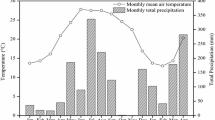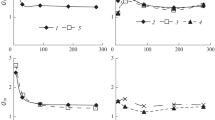Summary
Respiration rates of the forest floor, exclusive of the L layer, and of the mineral horizons from three soils developed under pine and hardwoods in the North Carolina Piedmont were measured with a Warburg respirometer. Respiration, based on carbon content of the soil, decreased with depth through the A1 horizon, but subdivisions of the A2 showed no difference. When all soil layers were considered, there were no significant differences in respiration between cover type or soil series. However, in the least decomposed organic layer, the F1, respiration of pine litter was 77 per cent of that of hardwood litter, and respiration of Georgeville or Colfax soils was only 58 per cent of that of Iredell soil. Regression analyses, primarily with inorganic soil nutrient factors, accounted for over 90 per cent of the variation in respiration in the organic layers but for less than 50 per cent in the mineral soil under hardwoods. Up to 15 factors were included in equations, but four factors explained at least 70 per cent of the variation accounted for by regression.
Similar content being viewed by others
References
Bremner, J. M., Nitrogen availability indexes. In Methods of Soil Analysis. Part 2. Chemical and Microbiological Properties, pp 1324–1325. Ed. C. A. Black. Am. Soc. Agron., Madison, Wis. (1965).
Broadfoot, W. M. and Pierre, W. H., Forest soil studies: I. Relation of rate of decomposition of tree leaves to their acid-base balance and other chemical properties. Soil Sci. 48, 329–348 (1939).
Coile, T. S., Soil changes associated with loblolly pine succession on abandoned agricultural land of the Piedmont plateau. Duke Univ. Sch. For. Bull. 5, 85 pp (1940).
Etherington, J. R. and Morrey, B. A., Nitrogen determination in nutrient cycling studies: An improved technique for handling multiple samples. J. Applied Ecol. 4, 431–433 (1967).
Jackson, M. L., Soil Chemical Analysis. Prentice Hall, Inc., Englewood Cliffs, N. J. (1958).
Olson, S. R. and Dean, L. A., Phosphorus. In Methods of Soil Analysis. Part 2. Chemical and Microbiological Properties, pp 1035–1049. Ed. C. A. Black. Am. Soc. Agron., Madison, Wis. (1965).
Parkinson, D. and Coups, E., Microbial activity in a podzol. In Soil Organisms, pp 167–175. Ed. J. Doeksen and J.van der Drift. North Holland Publ. Co., Amsterdam (1962).
Pratt, P. F., Potassium. In Methods of Soil Analysis. Part 2. Chemical and Microbiological Properties, pp 1022–1034. Ed. C. A. Black. Am. Soc. Agron., Madison, Wis. (1965).
Quarishi, M. S. I. and Cornfield, A. H., Effects of addition of varying levels of copper, as oxide or phosphate, on nitrogen mineralization and nitrification during incubation of a slightly calcarious soil receiving dried blood. Plant and Soil 35, 51–55 (1971).
Additional information
Principal Soil Scientists, U. S. Department of Agriculture, Forest Service, South-eastern Forest Experiment Station, Forestry Sciences Laboratory, Research Triangle Park, N. C. Mention of commercial products in this paper does not constitute endorsement by the U. S. Department of Agriculture.
Rights and permissions
About this article
Cite this article
Jorgensen, J.R., Well, C.G. The relationship of respiration in organic and mineral soil layers to soil chemical properties. Plant Soil 39, 373–387 (1973). https://doi.org/10.1007/BF00014804
Received:
Issue Date:
DOI: https://doi.org/10.1007/BF00014804




